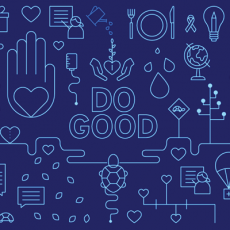- April 30, 2018
- By Chris Carroll
Leave it to University of Maryland students to find a way to turn dance parties into a source of millions of dollars to care for sick children. Or to develop a high-tech way to stop contaminants from fouling up recycling streams. Or to lead a charge to ensure moms-to-be and newborns get healthy food.
Those are some of the ideas that made the cut for the finals of the 2018 Do Good Challenge, the culmination of a year-long competition for students to make the greatest impact possible for their favorite cause or social issue.
The six finalists will go head to head Tuesday in a “Shark Tank”-like program competing for $20,000 in prize money they can use to further their causes. First-place winners in the two categories—“projects,” which maximize impact for a cause or existing organization through volunteering, fundraising and advocacy, and “ventures,” which are student-founded social enterprises that tackle social issues with innovative business models—each get $5,000 to further their causes, while runners-up receive smaller amounts.
The 113 teams that registered for the challenge this year represent a nearly 30 percent jump in participation from last year. Not only are teams becoming more numerous, they’re becoming more effective, says Toby Egan, faculty director of the Do Good Institute.
“Compared to prior years, the 2018 semifinalists would previously have made the finals—quality and innovation just keep deepening that much,” he says. “In terms of our campus ecosystem and the idea of Do Good impact that President Loh talks about, there’s so much room for optimism about what the students are accomplishing.”
The semifinalists were so good, Egan says, that they’ll have their own showcase outside the venue where the finals will take place.
This year’s judges are Michelle Gilliard, a partner in Venture Philanthropy Partners; Kahlil Kettering M.P.M. ‘15, urban conservation director for the Nature Conservancy’s Maryland/D.C. chapter; Linda Powers ’15, founder of Miles for Smiles; Dana Priest, two-time Pulitzer prize winner and John S. and James L. Knight Chair in Public Affairs Journalism at the Philip Merrill College of Journalism; Ben Simon ’14, CEO of Imperfect Produce and Jed Woelfle, managing director of Morgan Stanley.
Meet this year’s finalists:
Projects
 Nourish: Mommy and Me
Nourish: Mommy and Me
Team Nourish aims to improve maternal and infant health by promoting healthy eating during their pregnancy and providing the best possible nutrition to newborns. The team partners with the Gabriel Network, a nonprofit that helps women and families challenged with a crisis pregnancy, to deliver weekly “Nourish boxes” to expectant mothers in Maryland. These meal boxes include groceries, recipes and educational materials that offer pregnancy tips, health facts and more.
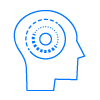 SPARC (Scholars Promoting And Revitalizing Care)
SPARC (Scholars Promoting And Revitalizing Care)
Making sure UMD students, faculty and staff have ready access to needed mental health services animates the SPARC team, which works both to raise student awareness of resources and to advocate to university leaders to keep expanding services. The group has distributed thousands of resource cards on campus, providing a handy list of what’s available, and collected, shared with university leadership and published dozens of letters from students with mental health needs to document gaps, says SPARC President and Founder Anthony Sartori ’18.
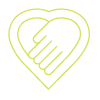 Terp Thon
Terp Thon
Marathon dance parties put on by Terp Thon, the largest student philanthropic organization at Maryland, have raised more than $4.2 million over nine years to support children, families, clinicians and caregivers in the Children’s National Health System. The group has begun to expand beyond the 12-hour dances (the same as a typical nurse’s shift) and recently ran a one-day fundraising drive that raised $50,000 to buy a CT machine for Children’s National. “This year we’re really focusing on expanding participation and reaching a larger portion of the campus community so we can have a larger impact,” says group member Amara Fox ’19. “It’s important for the doctors, nurses, patients and families to know they have the University of Maryland fighting alongside them.”
Ventures
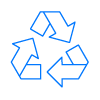 Recyclify
Recyclify
Recycling cuts resource consumption and disposal costs, but putting the wrong materials in the wrong bins results in contaminated trash that just winds up in a landfill anyway. The Recyclify group has developed a mobile app that tells UMD students which color-coded receptacle to put their trash in, while sensor-enabled recycling bins verify that everything winds up where it belongs. If they recycle right, students earn discounts from local retailers and restaurants. At the Stamp Student Union, the technology has cut recyclables contamination from 54 percent in standard bins to a squeaky-clean-by-industry-standards 8 percent in the Recyclify bin. “We’re solving a problem that universities have been trying to fix for years,” says team member Ardy Djourabtchi ’18. “And we expect our numbers to only get better.”
 Symbiont Health
Symbiont Health
Symbiont Health was born when team leader Erich Meissner ’18’s grandmother took a bad fall in 2016 and couldn’t get immediate help because she hadn’t been wearing her medical alert device, which she deemed uncomfortable. Geriatric falls are the leading cause of death among those older than 65, and also result in $31 billion of direct medical costs each year. The group’s technology automatically detects by implementing a mesh networking system for WiFi routers to better track patient behaviors in real time, with vital diagnostic information. The group plans to test a prototype in three senior living homes this year.
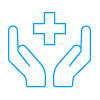 Synapto
Synapto
Getting a diagnosis of Alzheimer’s disease can take two years of expensive CT, MRI and other scans. The Synapto team, however, is developing a faster, cheaper method. “Speed is important, because the drugs for Alzheimer’s have a much higher chance of being effective at an earlier stage,” says team member Dhruv Patel ’20. The team’s technology analyzes brain scans made with a portable, 3-D printed EEG machine. A machine-learning algorithm compares biomarkers from a subject’s scan with those of a healthy brain, producing a diagnosis before symptoms are observable. The invention won first place and $20,000 in a National Institutes of Health undergraduate design competition last year.
Illustrations by Gabriella Hernandez
